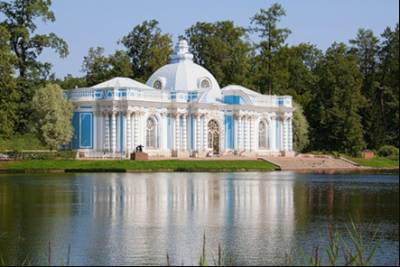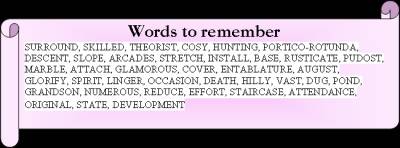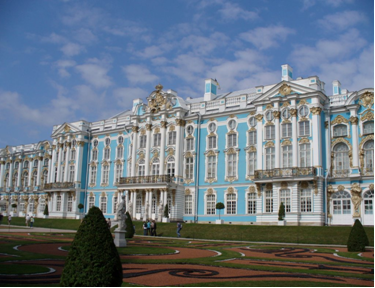
Parks and gardens The palace is surrounded by the magnificent Catherine and Alexander Parks with many pavilions, statues and decorative structures. The best 18th century masters – architects, sculptors, painters and gardeners – created Tsarskoye Selo ensemble. 
· B. Rastrelli built the Hermitage pavilions. · C. Cameron built the famous Gallery named after him. He was a skilled builder and a good theorist. In Tsarskoye Selo he created the exclusively cosy Agate Rooms in the hanging garden; their low facade was decorated with an oval portico-rotunda. Cameron lowered down a descent sloping on heavy arcades from the hanging garden to the park and he stretched a light ionic colonnade installed on heavy two-storey base of rusticated Pudost stone in the direction of the lake. It was for the entrance to it from the side facing the pond that a giant staircase was erected. · V. Neyelov built Palladian Bridge. A wonder in marble. · Yu. Felten and A. Rinaldi built the Tower Ruins and Chesma Pillar, monuments to Russian victories in the war against Turkey (1768-1774). · G. Quarenghi was all his life attached to magnificient colonnades as the most glamorous decorations. In Tsarskoye Selo he created nearly the most brilliant Corinthian Portico of Alexander’s Palace. The columns are installed there between the two pavilions covered by entablature, and they form an august entrance. Try to remember Chesma Pillar – Чесменская колонна Palladian Bridge – Палладиев мост Tower Ruins – Башня-руины Agate Rooms – Аппартаменты Агатового павильона Grotto – Садовый павильон, украшенный внутри раковинами и туром Hermitage Pavilion – Эрмитаж Cameron Gallery - Камеронова галерея Corinthian Portico of Alexander’s Palace – Колоннада из двух рядов белоснежных коринфских колонн. The highlights on the development of Tsarskoye Selo The development of Tsarskoye Selo can be divided into four main periods: 1710-1720 Tsarskoye Selo is still a small summer residence of empress Catherine I. It was built on a hilly place Saarskaya Myza. (The word "Tsarskoye” is not the derivative from "tsar”, but from the Finish word "saarynmoice” which means a hilly place!). 1740-1750 The palace was rebuilt by B. Rastrelli. The territory of parks was greatly enlarged. The main architectural style was Russian Baroque. 1760-1770 The main architectural style was Classicism. A. Rinaldi, V. Neyolov and Yu. Felten, C. Cameron and G. Quarenghi worked at that time. The first vast landscape park was created by V. Neyolov and D. Bush. The Catherine Park was the biggest in Russia. Many cannals and ponds were dug and across them many bridges were built. In 1780 – 1790, G. Quarenghi built a new big palace – Alexander Palace – and the Alexander Park for the elder grandson of Catherine II, Alexander Pavlovich. In 1778, a four-story building was built – the building of future Lyceum. The first part of the 19th century A new park was laid out on the territory of the place for hunting – Menagerie. The work was performed by L. Ruska and B. Stasov.
The spirit of the great Russian poet Very often Tsarskoye Selo is described as the town of muses. Much in this town reminds one of the young Pushkin. He was a student of the Tsarskoselsky Lyceum, and he lived here later as a well-known poet, glorifying the wonderful natural environment of Tsarskoye Selo. The spirit of the great Russian poet Alexander Pushkin seems to linger in every alley of the park. On the 19th of October, 1900, the monument to A. Pushkin was opened. In 1937, on the occasion of the 100th anniversary of Alexander Pushkin’s death the place was named after the great poet. 
The highlights on the development
of Tsarskoye Selo
The development of Tsarskoye Selo can
be divided into four main periods:
1710-1720
Tsarskoye
Selo is still a small summer residence of empress Catherine I. It was built on
a hilly place Saarskaya Myza. (The word "Tsarskoye” is not the derivative from
"tsar”, but from the Finish word "saarynmoice” which means a hilly place!).
1740-1750
The palace was
rebuilt by B. Rastrelli. The territory of parks was greatly enlarged. The main
architectural style was Russian Baroque.
1760-1770
The main
architectural style was Classicism. A. Rinaldi, V. Neyolov and Yu. Felten, C.
Cameron and G. Quarenghi worked at that time. The first vast landscape
park was created by V. Neyolov and D.
Bush. The Catherine Park was the biggest in Russia. Many cannals and ponds were
dug and across them many bridges were built.
In 1780 – 1790, G. Quarenghi built a
new big palace – Alexander
Palace – and the
Alexander Park for the elder grandson of Catherine II, Alexander Pavlovich.
In 1778,
a four-story building was built – the building of future
Lyceum.
The first part
of the 19th century
A new park
was laid out on the territory of the place for hunting – Menagerie. The work
was performed by L. Ruska and B. Stasov.


Architectural monuments of Tsarskoye Selo 1. The Cameron Gallery, 1783-1787. 2. The Lyceum, 1791 (designed by Ilya Neyolov and V. Stasov). The interiors restored in 1949-1973. 3. The Catherine Park, The Ballroom Pavilion, 1796, 1810-1811. Designed by P. Neyolov and L. Rusca. 4. The Catherine Park, The Catherine Hall. Designed by G. Quarenghi in 1782-1788. 5. Catherine Park, The Hermitage Pavilion. Designed by M. Zemtsov and B. Rastrelli in 1744-1746, 1749-1756. Restored in 1953-1954. 6. The Catherine Palace: the Great Hall (B. Rastrelli), the Main Staircase (J. Monighetti), Alexander I’s Marble Room (V. Stasov), the Picture Hall (B. Rastrelli), the Great Dining Room (Cameron), Courtiers’-in-Attendance. 
Vyborg Once a Karelian settlement and a trading point between the Novgorod merchants and Karel hunters, the Vyborg fortress was founded in 1293 by Torkel Knutson, then ruler of Sweden, after the Swedish soldiers had occupied the Karelian Isthmus. Vyborg because a town in 1403 by decree of Eric XIII of Sweden. Like other medieval towns it had its own court, council, merchant and craftsmen’s guilds. By 1470, the fortifications around Vyborg had been completed, built by the hands of Karels enslaved by the Swedes. From that time on Vyborg stood, a mighty fortress, constantly threatening the Russian borders. During the Russo-Swedish wars in the early 18th century Peter I besieged the fortress twice (in 1706 and 1710). At the second attempt the fortress was taken and Peter I is reported to have said at the time, "We have taken this town and St Petersburg is safe at last”. The town developed rather slowly until the construction (in 1856) of the Saimaa Canal connecting the Vyborg Bay with Saimaa Lakes. Vyborg became a trading centre. The St Petersburg-Vyborg railway line was opened in 1870. During the Great Patriotic War Vyborg was greatly damaged. By the road near the town boundary is a common grave of those who gave their lives fighting for the liberation of Vyborg in 1944, a bronze statue of a soldier marks this grave.
Zelenogorsk Zelenogorsk is a resort town on the Northern shore of the Gulf of Finland, situated in a pine-forest. There are many sanatoria and holiday homes here. The Golden Beach is an excellent sandy bathing beach. There are many hotels nearby Zelenogorsk. Zelenogorsk was called Terioki until 1948. Repino The great Russian artist Ilya Repin (1844-1930) spent almost 30 years of his life here in the estate he called "Penaty” (meaning "Penates”). Among Repin’s best known paintings are "The Volga Boatmen”, "The Religious Procession in Kursk Province”, "Ivan the Terrible and His Son” and "Zaporozhskie Cossaks”. Maxim Gorky, Fyodor Chaliapin, Vladimir Mayakovsky, Ivan Pavlov and other prominent figures of Russian culture visited Repin in his estate. Repin’s grave may be seen in the grounds of the estate. Sestroretsk In 1714, Peter I founded an ordance works near the Sestra (Sister) river, where the town of Sestroretsk now stands. Today it is the centre of a resort area. The area has been fashionable since thy days of old Petersburg. The Dubki Park remains from Peter I’s time. The name means "oaks” and according to legend Peter planted the trees himself. 1. Which one is different? 1) Neighbouring, occasion, portico, raise, shape, simultaneously 2) Revival, trustful, widespreading, bridegroom, glorify, height, plywood 3) Gaudiness, install, ornament, ordnance, portico, sloping 4) Sprinkler, splendor, spring, wing, hanging, length, linger 5) Theorist, threaten, nevertheless, corinthian, death, length 6) Glorify, valley, mighty, mistery, fiercely, cosy, scenary 2. Find the sentences with these expressions and translate them 1) The Necklace of Pearls. 2) A fine specimen of Classical architecture. 3) The blue expanse of the sea. 4) The wonderful play of the fountains. 5) A treasure-house of history. 6) "Samson Tearing the lion’s Mouth”. 7) The Petrine period. 8) The 17 artificial waterfalls linked by 5 arches of the grotto. 9) He could not show the whole splendor of his mastery. Add some more expressions or word combinations (about 10-15) from the text "Peterhof” and remember them. 3. Translate these into your language The palace group; raised from ashes; a public recreation zone; a short way from; under his supervision; clearly from afar; a wonder full of wonders; wide-spreading gulf; wooden slant; unique artistic unity; the lavishly decorated palace; it excelled in beauty; striking harmony and integrity; the seashore soon became rather busy; displayed no interest in the place; the focal point of the ensemble 4. Put in the missing words 1) The town of … is 26 km away from St Petersburg. 2) It is a … artistic complex of wonderful … , … palaces of huge… . 3) The palace s 300 metres in … . 4) The internal decor was the … of C. Cameron. 5) The palace apartments were finished with amazing … . 6) The pride of the palace was the … … . LENGTH, TSARSKOYE SELO, UNIQUE RESPONSIBILITY, PARKS, LUXURY, SPLENDID, DIMENSIONS, AMBER ROOM 5. Write the questions for the answers 1) …? The palace is surrounded by the two magnificient parks – Catherine and Alexander. 2) …? The best18th century masters created Tsarskoye Selo. 3) …? B. Rastrelli built the Grotto and the Hermitage Pavilions. 4) …? Agate Rooms were built in the hanging garden. 5) …? No, the Palladian Bridge was built in marble. Edited by Alena Alexeeva Valentin Alexeev Students of class 9 B | 
